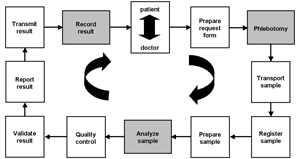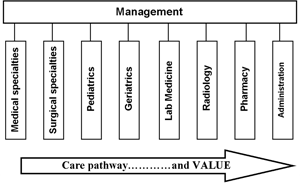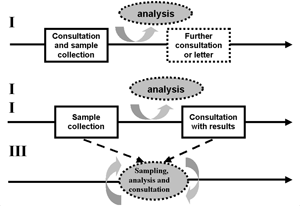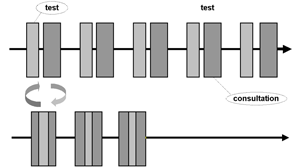Printed from acutecaretesting.org
January 2008
Point-of-care testing; systems re-engineering of healthcare provision to reduce errors, and improve outcomes
INTRODUCTION
Up until the late twentieth century, there was a trend in healthcare provision for care away from the home and into a range of increasingly complex facilities including local health centers – at the community level including doctors offices and community hospitals (primary care), to local hospitals providing a limited range of services, e.g. emergency care (secondary care), through to specialist hospitals (tertiary care).
Over the last decade there has been a shift in healthcare policy, seeking to move more care closer to home whilst also recognizing the need to concentrate the highly specialized procedures into specialist centers, e.g. trauma centers.
There has been a parallel evolution in the provision of laboratory medicine services with the change from testing at the bedside and in the side-room of a ward, to a separate laboratory and then to off-site laboratory facilities and to reference laboratories.
This evolution has occurred with our increasing understanding of the pathophysiology of disease, and through technological innovation that has provided both diagnostic tools and treatments.
However this change has sometimes been at the expense of recognizing the patient’s needs, instead putting technology first. In addition, because of the increasing fragmentation of care, this change has led to an increasing incidence of medical errors as documented in several reports [1,2].
The development of point-of-care testing (POCT) today reflects a parallel change to that occurring in the provision of healthcare, providing an opportunity to facilitate that policy change to care closer to home, as well as reducing the fragmentation of care.
ERRORS AND SOURCES OF ERROR
Several studies have shown that a high proportion of the errors associated with the use of laboratory medicine services occur in the pre- and post-analytical phases, and with a frequency that would not be tolerated in other service orientated industries [3].
Studies have also shown that turnaround time for results can vary quite significantly depending on how far the requester of the service is from the provider, a facet obviously dependent on the investment in logistics [4].
Surveys have also shown less user satisfaction with the pre- and post-analytical phases of the laboratory service [5]. Interestingly Collinson et al [6], commenting on the use of POCT for cardiac markers in the coronary care unit, suggested that one of the advantages of providing results quickly following the request was that it enabled the clinician to remain engaged with that immediate patient episode – thereby reducing the risk of error.
Leape et al [7] categorized sources of error into four categories - diagnostic, treatment, preventive and other. Diagnostic errors include failure to employ the indicated (or correct) test, a failure to act on results, or an error or delay in the diagnosis.
Treatment errors can include an error in the performance of the procedure or test, a delay in the treatment or response to the test, or an error in administering the treatment.
Preventive errors are concerned with inadequate monitoring or follow-up. Leape’s category of ‘other’ probably represents one of the most common errors seen in a number of guises, namely a failure of communication.
Whilst laboratory professionals might see this as a problem of the results not getting back into the patients record, there are reported instances where results are not acted upon [8] or tests not ordered or results recorded in the patient’s notes [9].
Norris et al [10] systematically reviewed disease management programmes for diabetes and found an increase in HbA1c monitoring of 15.6 % (Inter-quartile range [IQR] 4 % to 39 %, n = 15 studies), an increase in urine protein screening of 9.6 % (IQR 0 % to 44 %, n = 7 studies), a reduction in the HbA1c 0.5 % (IQR -1.35 to -0.1 %, n = 19 studies), and a reduction in the utilization of healthcare facilities of 31 % (IQR -82.3 % to +11.3 %, n = 5 studies).
Whilst the studies included in this review might not have used POCT, one of the objectives of a disease management programme is to increase the communication between the users and the providers of the service, improving the ‘connectivity’ between the patient, the laboratory and the clinician.
HEALTCARE PROVISION IN THE FUTURE
The Institute of Medicine identified six aims as the core to providing a solution to reducing medical errors in the US healthcare system [11] - a service should be (i) safe – avoiding harm, (ii) effective – evidence based, (iii) patient centered – respecting individual needs and values, (iv) timely – minimizing delays, (v) efficient – avoiding waste, and (vi) equitable – of equal quality for all.
In the first report of a recent review of healthcare provision in the United Kingdom, Darzi [12] set out similar objectives for the health service of the future as (i) fair – equally available to all, (ii) personalized – to individual needs, (iii) effective – providing quality outcomes, and (iv) safe – offering confidence in the care received.
Technological innovation in the field of POCT is now such that it is possible to deliver analytical quality that is comparable with that provided by the central laboratory.
Thus if the quality can be maintained at the bedside and in the clinic, then POCT is in a unique position to deliver the objectives as set out by the Institute of Medicine, and by Darzi, as well as by other similar initiatives in other countries.
In order to achieve this there are several challenges that must be met and conquered and these include (i) a comprehensive quality management system that recognizes that the POCT technology will be operated by health professionals with limited technical skill, as well as patients, (ii) a system of ‘connectivity’ that embraces not only the results being recorded in the patient record but that ensures that patient and carer are aware of the results (and their meaning) and that the results are acted upon in a correct manner.
The system must ensure that the right patient gets the right test, that the right sample is taken at the right time, that the right result is reported, that the right decision is made and the right action taken, ensuring that the best outcome can be achieved.
POCT REDUCING ERRORS AND IMPROVING OUTCOMES
There are at least 12 steps in obtaining the results of a laboratory investigation and there can be many more depending on the level of IT connectivity both at the requesting and reporting level, the sample identification and logistics arrangements, and the sample reception and handling in the laboratory.
Many of these steps can be eliminated using POCT as illustrated in FIGURE 1. When the testing process has been optimized, the interaction between the doctor, or other care giver, and the patient then becomes the focus of attention and here the choice of POCT needs to have been tested in order determine its effectiveness and to show that it delivers the expected benefits.
The overall objective of improving health outcomes is to maximize the benefit and minimize the risk in the care of individual patients, at reasonable cost. This can be broken down into determining how POCT can help with the following aspects of patient care:
(i) triage of the patient at the time of acute presentation and any action that might follow
(ii) treatment choice and optimization
(iii) compliance management
(iv) providing both satisfaction and convenience to the patient and to the caregiver, and
(v) providing value for money for all stakeholders [13-15].
FIGURE 1:
The steps involved in making a test request when using a laboratory service. The minimum steps for POCT are shown are shown by the shaded boxes.
Click for enlargement

Modified with permission from reference 15.
The Institute of Medicine concluded that the underlying reasons for inadequate quality were the impacts of (i) the increasing complexity of science and technology, (ii) the increase in chronic conditions, (iii) an inability to exploit IT, and (iv) poorly organized delivery systems [11].
POCT is in a unique position to address some of these problems, first by helping to reduce the errors associated with delivery of services by reducing the complexity and fragmentation of delivery, and secondly by providing better connectivity of testing with the patient record, as well as enabling the caregiver to utilize a laboratory investigation at the time its need becomes evident, e.g. at the point of care, as well as enabling chronic condition management to be delivered closer to home.
Price and Kricka [16] reported the deliberations of a 2006 workshop on ‘Improving Health Care Accessibility Through Point Of Care Technologies’, sponsored by the National Institute of Biomedical Imaging and Bioengineering, the National Heart, Lung and Blood Institute (National Institutes of Health) and the National Science Foundation.
The workshop assessed the emerging clinical needs and opportunities driving the use of POCT technologies in primary care, the home, and the emergency medical services.
It also reviewed POCT technologies including minimally and noninvasive testing as well as imaging, together with the use of more conventional in vitro diagnostic testing based on sensor and miniaturized analytical systems.
Emerging needs of informatics and telehealth and health care systems engineering were considered in the context of POCT.
The workshop developed a series of recommendations directed towards specific aspects of advancing POCT technologies and these were centered on (i) understanding the needs of the patient, clinician, healthcare provider and healthcare purchase, (ii) understanding how POCT technologies will change the process of care, (iii) stimulating research support for multidisciplinary research and technology development in POCT devices, and (iv) technical validation and outcome studies [16].
RE-ENGINEERING OF HEALTHCARE PROVISION
The classic approach to the organization and management of healthcare provision is in silos, in which individual components of a provider organization, e.g. a hospital, is organized and managed in relation to its objectives.
For example, in the case of a laboratory “silo”, its performance is judged according to the quality and turnaround of the results, as well as the cost of delivering those results.
Invariably other aspects of the service that impact on the use of the laboratory service, might be managed by another part of the organization, e.g. specimen transport or IT.
Furthermore there is little incentive for the laboratory to promote POCT, because it might take away business from the laboratory (a key performance metric) whilst also costing more to provide the test.
Invariably problems that occur in the healthcare system, e.g. a hospital, have to be dealt with at a higher level in the organization.
In order to provide a more patient-centric service it is necessary to work across the silos and to focus on the care pathway or the patient journey [17], as illustrated in FIGURE 2.
It is argued that this will help to provide a more efficient service, as well as a more effective service, as it reduces the risk of errors and the fragmentation that currently occurs as a result of the silo approach [15].
The operational perspective on this solution is that healthcare professionals will have to work differently, and patterns of clinical practice will have to change. Two examples of where practice will change are shown in FIGURES 3 and 4.
The economic perspective on this solution is that it is necessary to consider the cost of the episode of care rather than focus on the cost of the individual components, and whilst providing the test using POCT might be greater, the cost of the episode of care will be equal or less.
The challenge of this approach is that it requires that resources are allocated differently across silos – if these silos need to continue to exist.
FIGURE 2:
A traditional organization chart for a health care organization, indicating the relationship between the management and the various delivery and support functions - the silos.
Providing more patient-centered care and providing value to the care pathway requires crossing these silo boundaries, also emphasizing that the value might be found in several silos.

Modified with permission from reference 15.
FIGURE 3:
Schematic representation to show the care pathway for a patient with diabetes mellitus attending a clinic for regular review. The two uppermost options are where the patient either attends for the consultation at which time the blood is taken for HbA1c, etc.
and the result communicated later, or the patient attends ahead of the consultation to have the blood taken, the result being available at the consultation.
The third option, facilitated by POCT, enables the blood to be taken, the analysis performed and the consultation informed by the result all taking place at one visit.

Modified with permission from reference 15.
FIGURE 4:
Schematic representation of a care pathway in which a patient attending a clinic requires a test in order to determine the dosage of a drug, with subsequent visits to assess efficacy of dose and then optimize.
In the upper scenario using a laboratory service a visit is required to provide a blood sample and then a second visit for the consultation, etc. In the lower scenario using POCT there are fewer visits, and faster optimization.
The scenario of the first visit could also represent the case of a patient requiring a test for candidacy for a drug, e.g. Her-2/neu status and Herceptin, or to assess dosage, e.g.
TPMT status and azothioprine. Key: the light shading denotes the phlebotomy visit and the dark shading the consultation visit.

Modified with permission from reference 15.
CONCLUSIONS
POCT offers the opportunity to reduce errors and improve the quality of care. This will require good quality management of the service and the difficult challenge of re-engineering of the process of care.
References+ View more
- Institute of Medicine. Editors Kohn LT, Corrigan JM, Donaldson MS. To Err is Human: building a safer health system. National Academies Press, Washington; 2000: 287.
- Davis K., Schoen C, Schoenbaum SC, Audet A-MJ, Doty MM, Holgren AL, Kriss JL. Mirror, mirror on the wall: an update on the quality of American health care through the patient’s lens. The Commonwealth Fund, April 2006.
- Nevalainen D, Berte L, Kraft C, Leigh E, Picaso L, Morgan T. Evaluating laboratory performance on quality indicators with the six sigma scale. Arch Pathol Lab Med 2000; 124: 516-9
- Steindel SJ, Jones BA. Routine outpatient laboratory test turnaround times and practice patterns: a College of American Pathologists Q-Probes study. Arch Pathol Lab Med 2002; 126: 11-8.
- Jones BA, Walsh MK, Ruby SG. Hospital nursing satisfaction with clinical laboratory services: a College of American Pathologists Q-Probes study of 162 institutions. Arch Pathol Lab Med 2006; 130: 1756-61.
- Collinson PO, John C, Lynch S, Rao A, Canepa-Anson R, Carson E, Cramp D. A prospective randomized controlled trial of point-of-care testing on the coronary care unit. Ann Clin Biochem 2004; 41: 397-404.
- Leape LL, Lawthers AG, Brennan TA, Johnson WG. Preventing medical injury. QRB Qual Rev Bull 1993; 19: 144-9.
- Kilpatrick ES, Holding S. Use of computer terminals on wards to access emergency test results; a retrospective audit. BMJ 2001; 322: 1101-3.
- Peters AL, Legorreta AP, Ossorio RC, Davidson MB. Quality of outpatient care provided to diabetic patients. A health maintenance organization experience. Diabetes Care 1996; 19: 601-6.
- Norris SL, Nichols PJ, Caspersen CJ, Glasgow RE, Engelgau MM, Jack L, et al. The effectiveness of disease and case management for people with diabetes. A systematic review. Am J Prev Med 2002; 22 (4 Suppl): 15-38.
- Institute of Medicine (Committee on Quality of Health Care in Medicine). Crossing the Quality Chasm: a new health system for the 21st century. National Academies Press, Washington; 2001.
- Lord Darzi. NHS Next Stage Review Interim Report. Our NHS, Our Future. Department of Health, London, 2007.
- Price CP, Christenson RH (Editors). Evidence-Based Laboratory Medicine: principles, practice and outcomes. Second Edition. Washington, AACC Press; 2007.
- Price CP, StJohn A, Hicks JM (Editors). Point-of-Care Testing. Second Edition. Washington, AACC Press; 2004.
- Price CP, St John A. Point-of-Care Testing for Managers and Policymakers: from rapid testing to better outcomes. Washington, AACC Press; 2006.
- Price CP, Kricka LJ. Improving healthcare accessibility through point-of-care technologies. Clin Chem 2007; 53: 1665-75.
- National Academy of Engineering and Institute of Medicine. Editors Reid PP, Compton WD, Grossman JH, Fanjiang G. Building a Better Delivery System. Washington, National Academies Press; 2005.
References
- Institute of Medicine. Editors Kohn LT, Corrigan JM, Donaldson MS. To Err is Human: building a safer health system. National Academies Press, Washington; 2000: 287.
- Davis K., Schoen C, Schoenbaum SC, Audet A-MJ, Doty MM, Holgren AL, Kriss JL. Mirror, mirror on the wall: an update on the quality of American health care through the patient’s lens. The Commonwealth Fund, April 2006.
- Nevalainen D, Berte L, Kraft C, Leigh E, Picaso L, Morgan T. Evaluating laboratory performance on quality indicators with the six sigma scale. Arch Pathol Lab Med 2000; 124: 516-9
- Steindel SJ, Jones BA. Routine outpatient laboratory test turnaround times and practice patterns: a College of American Pathologists Q-Probes study. Arch Pathol Lab Med 2002; 126: 11-8.
- Jones BA, Walsh MK, Ruby SG. Hospital nursing satisfaction with clinical laboratory services: a College of American Pathologists Q-Probes study of 162 institutions. Arch Pathol Lab Med 2006; 130: 1756-61.
- Collinson PO, John C, Lynch S, Rao A, Canepa-Anson R, Carson E, Cramp D. A prospective randomized controlled trial of point-of-care testing on the coronary care unit. Ann Clin Biochem 2004; 41: 397-404.
- Leape LL, Lawthers AG, Brennan TA, Johnson WG. Preventing medical injury. QRB Qual Rev Bull 1993; 19: 144-9.
- Kilpatrick ES, Holding S. Use of computer terminals on wards to access emergency test results; a retrospective audit. BMJ 2001; 322: 1101-3.
- Peters AL, Legorreta AP, Ossorio RC, Davidson MB. Quality of outpatient care provided to diabetic patients. A health maintenance organization experience. Diabetes Care 1996; 19: 601-6.
- Norris SL, Nichols PJ, Caspersen CJ, Glasgow RE, Engelgau MM, Jack L, et al. The effectiveness of disease and case management for people with diabetes. A systematic review. Am J Prev Med 2002; 22 (4 Suppl): 15-38.
- Institute of Medicine (Committee on Quality of Health Care in Medicine). Crossing the Quality Chasm: a new health system for the 21st century. National Academies Press, Washington; 2001.
- Lord Darzi. NHS Next Stage Review Interim Report. Our NHS, Our Future. Department of Health, London, 2007.
- Price CP, Christenson RH (Editors). Evidence-Based Laboratory Medicine: principles, practice and outcomes. Second Edition. Washington, AACC Press; 2007.
- Price CP, StJohn A, Hicks JM (Editors). Point-of-Care Testing. Second Edition. Washington, AACC Press; 2004.
- Price CP, St John A. Point-of-Care Testing for Managers and Policymakers: from rapid testing to better outcomes. Washington, AACC Press; 2006.
- Price CP, Kricka LJ. Improving healthcare accessibility through point-of-care technologies. Clin Chem 2007; 53: 1665-75.
- National Academy of Engineering and Institute of Medicine. Editors Reid PP, Compton WD, Grossman JH, Fanjiang G. Building a Better Delivery System. Washington, National Academies Press; 2005.
May contain information that is not supported by performance and intended use claims of Radiometer's products. See also Legal info.
Acute care testing handbook
Get the acute care testing handbook
Your practical guide to critical parameters in acute care testing.
Download nowScientific webinars
Check out the list of webinars
Radiometer and acutecaretesting.org present free educational webinars on topics surrounding acute care testing presented by international experts.
Go to webinars









